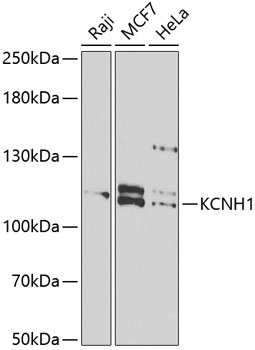Signal Transduction Antibodies 3
Anti-KCNH1 Antibody (CAB6636)
- SKU:
- CAB6636
- Product Type:
- Antibody
- Reactivity:
- Human
- Reactivity:
- Mouse
- Reactivity:
- Rat
- Host Species:
- Rabbit
- Isotype:
- IgG
- Antibody Type:
- Polyclonal Antibody
- Research Area:
- Signal Transduction
Description
| Antibody Name: | Anti-KCNH1 Antibody |
| Antibody SKU: | CAB6636 |
| Antibody Size: | 20uL, 50uL, 100uL |
| Application: | WB |
| Reactivity: | Human, Mouse, Rat |
| Host Species: | Rabbit |
| Immunogen: | Recombinant fusion protein containing a sequence corresponding to amino acids 813-962 of human KCNH1 (NP_002229.1). |
| Application: | WB |
| Recommended Dilution: | WB 1:500 - 1:2000 |
| Reactivity: | Human, Mouse, Rat |
| Positive Samples: | Raji, MCF7, HeLa |
| Immunogen: | Recombinant fusion protein containing a sequence corresponding to amino acids 813-962 of human KCNH1 (NP_002229.1). |
| Purification Method: | Affinity purification |
| Storage Buffer: | Store at -20'C. Avoid freeze / thaw cycles. Buffer: PBS with 0.02% sodium azide, 50% glycerol, pH7.3. |
| Isotype: | IgG |
| Sequence: | FKDA CGKS EDWN KVSK AESM ETLP ERTK ASGE ATLK KTDS CDSG ITKS DLRL DNVG EARS PQDR SPIL AEVK HSFY PIPE QTLQ ATVL EVRH ELKE DIKA LNAK MTNI EKQL SEIL RILT SRRS SQSP QELF EISR PQSP ESER DIFG AS |
| Gene ID: | 3756 |
| Uniprot: | O95259 |
| Cellular Location: | Cell membrane, Early endosome membrane, Multi-pass membrane protein, Nucleus inner membrane |
| Calculated MW: | 108kDa/111kDa |
| Observed MW: | 111kDa |
| Synonyms: | KCNH1, EAG, EAG1, Kv10.1, TMBTS, ZLS1, h-eag, hEAG1 |
| Background: | Voltage-gated potassium (Kv) channels represent the most complex class of voltage-gated ion channels from both functional and structural standpoints. Their diverse functions include regulating neurotransmitter release, heart rate, insulin secretion, neuronal excitability, epithelial electrolyte transport, smooth muscle contraction, and cell volume. This gene encodes a member of the potassium channel, voltage-gated, subfamily H. This member is a pore-forming (alpha) subunit of a voltage-gated non-inactivating delayed rectifier potassium channel. It is activated at the onset of myoblast differentiation. The gene is highly expressed in brain and in myoblasts. Overexpression of the gene may confer a growth advantage to cancer cells and favor tumor cell proliferation. Alternative splicing of this gene results in two transcript variants encoding distinct isoforms. |
| UniProt Protein Function: | Kv10.1: Pore-forming (alpha) subunit of voltage-gated non- inactivating delayed rectifier potassium channel. Channel properties may be modulated by cAMP and subunit assembly. Mediates IK(NI) current in myoblasts. Belongs to the potassium channel family. H (Eag) (TC 1.A.1.20) subfamily. Kv10.1/KCNH1 sub-subfamily. 2 isoforms of the human protein are produced by alternative splicing. |
| UniProt Protein Details: | Protein type:Membrane protein, multi-pass; Membrane protein, integral Chromosomal Location of Human Ortholog: 1q32.2 Cellular Component: nucleoplasm; voltage-gated potassium channel complex; integral to plasma membrane; early endosome membrane; cytoplasm; plasma membrane; nuclear inner membrane Molecular Function:calmodulin binding; protein binding; cyclic nucleotide binding; delayed rectifier potassium channel activity; two-component sensor activity Biological Process: synaptic transmission; regulation of membrane potential; two-component signal transduction system (phosphorelay); potassium ion transport; myoblast fusion; regulation of cell proliferation Disease: Zimmermann-laband Syndrome 1; Temple-baraitser Syndrome |
| NCBI Summary: | Voltage-gated potassium (Kv) channels represent the most complex class of voltage-gated ion channels from both functional and structural standpoints. Their diverse functions include regulating neurotransmitter release, heart rate, insulin secretion, neuronal excitability, epithelial electrolyte transport, smooth muscle contraction, and cell volume. This gene encodes a member of the potassium channel, voltage-gated, subfamily H. This member is a pore-forming (alpha) subunit of a voltage-gated non-inactivating delayed rectifier potassium channel. It is activated at the onset of myoblast differentiation. The gene is highly expressed in brain and in myoblasts. Overexpression of the gene may confer a growth advantage to cancer cells and favor tumor cell proliferation. Alternative splicing of this gene results in two transcript variants encoding distinct isoforms. [provided by RefSeq, Jul 2008] |
| UniProt Code: | O95259 |
| NCBI GenInfo Identifier: | 26006799 |
| NCBI Gene ID: | 3756 |
| NCBI Accession: | O95259.1 |
| UniProt Secondary Accession: | O95259,O76035, Q14CL3, B1AQ26, |
| UniProt Related Accession: | O95259 |
| Molecular Weight: | 989 |
| NCBI Full Name: | Potassium voltage-gated channel subfamily H member 1 |
| NCBI Synonym Full Names: | potassium voltage-gated channel, subfamily H (eag-related), member 1 |
| NCBI Official Symbol: | KCNH1 |
| NCBI Official Synonym Symbols: | EAG; EAG1; h-eag; Kv10.1 |
| NCBI Protein Information: | potassium voltage-gated channel subfamily H member 1; hEAG1; EAG channel 1; ether-a-go-go potassium channel 1; ether-a-go-go, Drosophila, homolog of; voltage-gated potassium channel subunit Kv10.1 |
| UniProt Protein Name: | Potassium voltage-gated channel subfamily H member 1 |
| UniProt Synonym Protein Names: | Ether-a-go-go potassium channel 1; EAG channel 1; h-eag; hEAG1; Voltage-gated potassium channel subunit Kv10.1 |
| Protein Family: | Potassium voltage-gated channel subfamily |
| UniProt Gene Name: | KCNH1 |
| UniProt Entry Name: | KCNH1_HUMAN |
View AllClose







